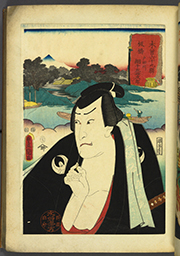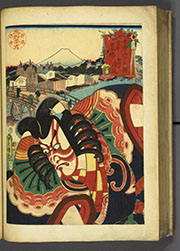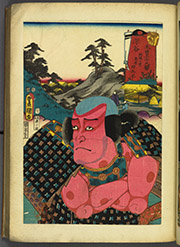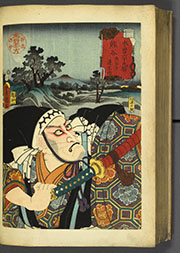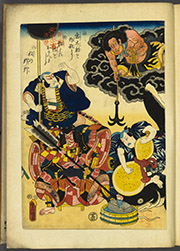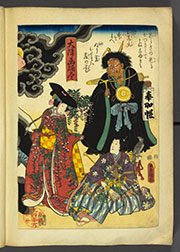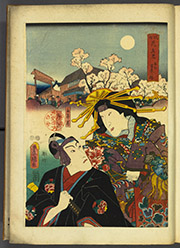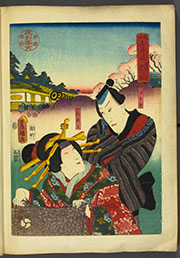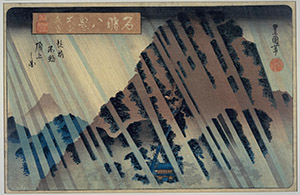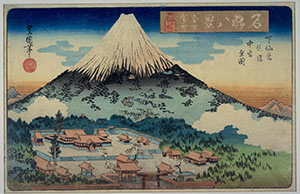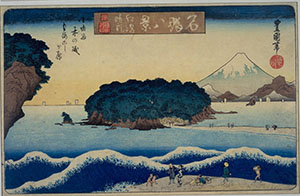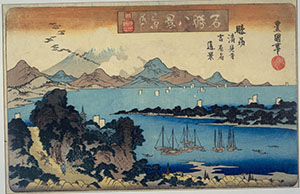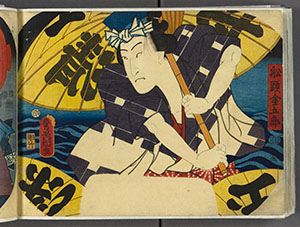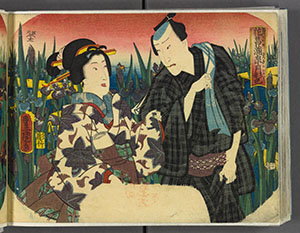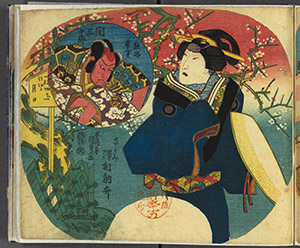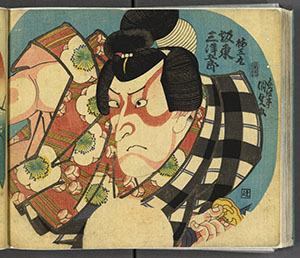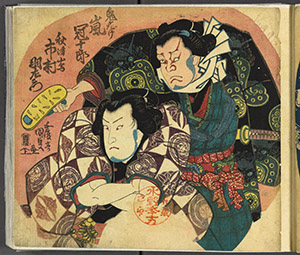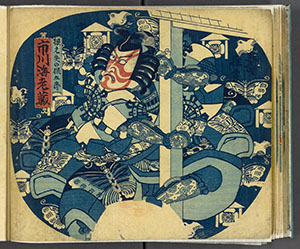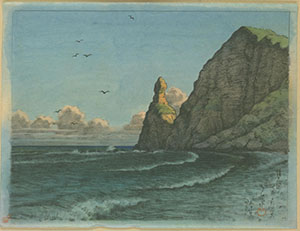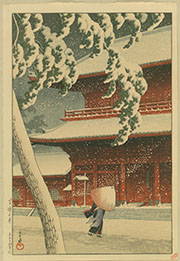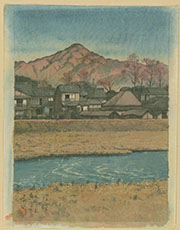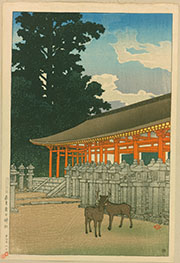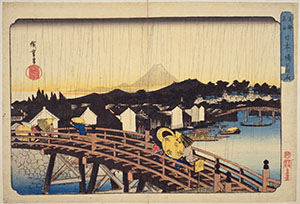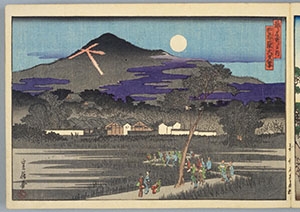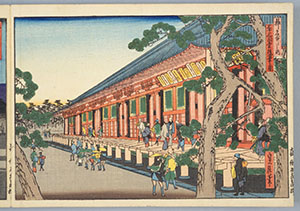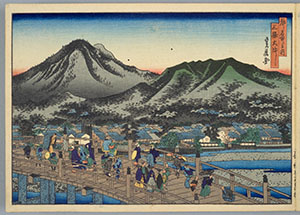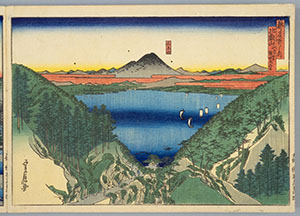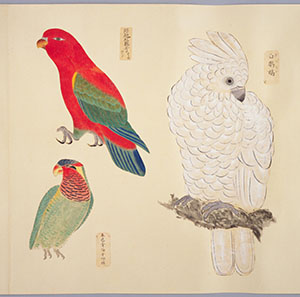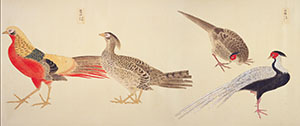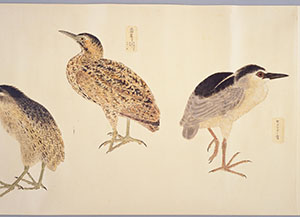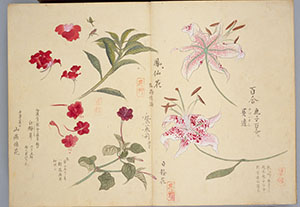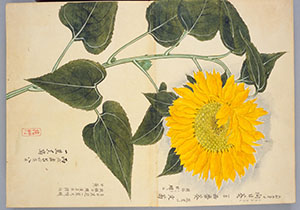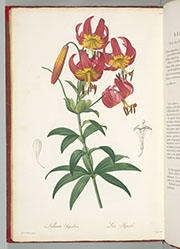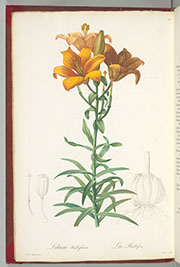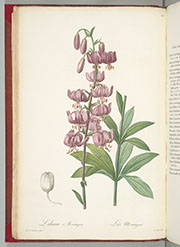70th Anniversary Commemorative Exhibit "A Treasure Box of Books - The 70-year History of the National Diet Library and Its Collections"
- A Treasure Box of Books
- Part 2 Diverse Collections
- Chapter 1 Beautiful Books and Rare Books
- Section 4 Nishiki-e (Color Woodblock Prints) and Natural History
Part 2 Chapter 1 Section 4 Nishiki-e (Color Woodblock Prints) and Natural History
This exhibit includes nishiki-e (color woodblock prints) and modern paintings selected from among the 10,000 nishiki-e and related works held by the National Diet Library. The exhibit also includes works depicting animals, plants, and other natural history related items. The National Diet Library holds a great number of such materials, and has the leading collection of Japanese natural history materials in the country. Great progress has also been made on digitizing and uploading these works to the internet.
50 Azumanishiki-e by UTAGAWA Toyokuni III in the late Edo Period [234-38]
This is a collection of 114 nishiki-e (brocade pictures) and other works depicting kabuki actors pictured at stations along the Tokaido and Kiso Kaido roads. This collection highlights the perfected techniques of Utagawa Toyokuni III, who was a leading figure in ukiyo-e and one of the premier yakusha-e (actor prints) artists during the last days of the Tokugawa shogunate.
On the right is depicted Soga no Goro Tokimune (portrayed by Ichikawa Ebizo V), known for the "Revenge of the Soga Brothers" incident, against the backdrop of Nihonbashi, and on the left is depicted Aboshi Samojiro (Arashi Kichisaburo III), the masterless samurai who appears in the Nanso Satomi hakken den, against the backdrop of the Itabashi Toda River. Both works are from 1852.
Digital Collections
On the right is depicted Renshobo (Ichikawa Ebizo V or Ichikawa Danjuro VIII) against the backdrop of Kumagaya-shuku's Yukokuji Temple, and on the left is depicted Ubara no Tagohei (Asao Okuyama III) against the backdrop of Fukaya-shuku's Okabegahara. Both works are from 1852.
Digital Collections
This work is titled Otsu-e odorizukushi (the displayed section is two pages of a three-page triptych), and depicts kabuki actors playing characters that appear in the Giga Otsu-e (Otsu-e caricature) from Otsu, including Nakayama Bungoro II's Oni no kannebutsu (Ogre's reciting Buddhist invocations in midwinter), Bando Shuka I's Fujimusume (Wisteria maiden), and Iwai Kumesaburo III's falconer. The work is from between 1848 and 1854.
Digital Collections
On the right are depicted the young master Yogoro (Ichikawa Danjuro VIII) and the prostitute Azuma (Onoe Kikujiro II), and on the left are depicted the prostitute Agemaki (Bando Shuka I) and the wandering warrior Sukeroku (Ichikawa Danjuro VIII) against the backdrop of Toto Yoshiwara. Both works are from 1852.
Digital Collections
51 Oyama yau (from Meisho Hakkei) (Eight Views of Beautiful Places) illustrated by UTAGAWA Toyokuni II, around 1833-1834 [WA33-7]
Fuji bosetsu (from Meisho Hakkei) (same as above)
Enoshima seiran (from Meisho Hakkei) (same as above)
Miho rakugan (from Meisho Hakkei) (same as above)
Utagawa Toyokuni II's magnum opus. The work features eight scenic spots including Musashi, Sagami, and Suruga, depicted in the style of the Omi Hakkei and other works. The collection held by the National Diet Library is missing the "Tamagawa shugetsu" piece. Influenced by the landscapes of Hokusai and Hiroshige, this work makes abundant use of indigo, green, and warm colors and features a profound and elaborate artistic style.
- Oyama yau
- The exhibited material "Oyama yau" depicts a heavy rain beating down in bold and dynamic brushstrokes. Oyama is also called "Aburi yama (rainy mountain)" and was known for the Oyama mairi (pilgrimage to Oyama).
Digital Collections
- Fuji bosetsu
- The exhibited material Fuji bosetsu is a picture which provides a panoramic view of the area from the Shimosengenpilgrim's lodging to Mount Fuji covered in snow. One can also see pilgrims to Mount Fuji in the painting.
Digital Collections
- Enoshima seiran
- The exhibited material Enoshima seiran depicts Morokoshigahara and the rocky shore of Koyurugi. The depiction of the waves is powerful, making one feel as if the waves will actually come crashing towards them.
Digital Collections
- Miho rakugan
- The exhibited material Miho rakugan depicts Yoshiwara-shuku (present day Fuji City in Shizuoka Prefecture) and Seikenji Temple located on the mountainside of Kaidouwaki with Miho no matsubara to the right. The piece gives one a sense of peaceful elegance.
Digital Collections
52 Haiyu uchiwae by UTAGAWA Toyokuni III et al. [237-377]
This is a collection of 154 uchiwae, illustrated Japanese round fans depicting portraits of kabuki actors. Uchiwae refers to ukiyo-e prints produced for the purpose of being applied to Japanese round fans.
On the right is depicted sendo (boatman) Kingoro (portrayed by Bando Hikosaburo V and produced in 1856) and on the left is depicted the theme known as Mitategonin'otoko Gohiikinoonshi which shows a gallant, young man (actor unknown) trying to decipher a text under the light of a paper-covered lamp (produced in 1852).
Digital Collections
The exhibited sections depict the theme of Hanashobu satsukinosaishiki featuring an affectionate young couple (actors unknown) (produced in 1858).
Digital Collections
53 Yakusha nigaoe uchiwae by GOTOTEI Kunisada in the late Edo Period [237-376]
This is a collection of 90 uchiwae, illustrated Japanese round fans depicting portraits of kabuki actors. Gototei Kunisada was later known as Utagawa Toyokuni III. Uchiwae refers to ukiyo-e prints produced for the purpose of being applied to Japanese round fans.
On the right is depicted Umeomaru from Sugawara denju tenarai kagami portrayed by Bando Mitsugoro IV (produced in 1832), and on the left are depicted Kumagai Naozane and his wife Sagami from Ichinotani futaba gunki portrayed by Seki Sanjuro III and Sawamura Tossho I (produced in 1837).
Digital Collections
On the right is depicted Soga no Goro Tokimune from Ya no ne portrayed by Ichikawa Ebizo V (produced in 1830), and on the left are depicted Onigatake and Akitsushima from Sekitori nidai no shoubuzuke portrayed by Arashi Kanjuro I and Ichimura Uzaemon XII (produced in 1836).
Digital Collections
54 Shiribeshinokuni setakamuiiwa by KAWASE Hasui in 1935 [寄別7-3-1-7]
55 Shiba zojoji (Tokyo juunidai hoka no uchi) by KAWASE Hasui in 1925 [寄別7-6-1-1]
58 Kyoto kamigamo illustrated by KAWASE Hasui, KAWASE Hasui, in 1934 [寄別7-3-1-7]
59 Nara kasuga jinja (Tabimiyage dai 2 shu no uchi) by KAWASE Hasui in 1921 [寄別7-3-1-3 i]
Kawase Hasui is one of the most prominent modern landscape print artists. He visited areas all over Japan and created a great number of sketches of landscapes and prints based on those sketches. He was also called the "traveler poet" and "travelling printmaker" and is also popular overseas.
- Shiribeshinokuni setakamuiiwa
- Setakamuiiwa is an 80 m high, strangely shaped rock along the city limits of Yoichi Town and Furubira Town in Hokkaido. Setakamui is Ainu for "dog god".
Digital Collections
- Shiba zojoji (Tokyo juunidai hoka no uchi)
- The exhibited materials are one of Hasui's most well-known works, sentimentally depicting Japanese landscapes. These were the best-selling of his works during Hasui's lifetime, and it is said that over 3,000 prints were made.
Digital Collections
- Kyoto kamigamo
- From the exhibited materials one can get a sense of the unspoiled landscapes of rural Kyoto and Japan from the early Showa Era. There are still prints remaining based on this watercolor painting.
Digital Collections
- Nara kasuga jinja (Tabimiyage dai 2 shu no uchi)
- Nara's Kasuga Shrine (present day Kasuga Taisha) is the grand head shrine of all of the Kasuga Shrines throughout Japan. Deer are considered divine messengers because the deity Takemikazuchi no mikoto appeared riding on a white deer.
Digital Collections
56 Nihonbashi by Noël Nouet, printed by DOI Hangaten in 1936 [本別7-327]
57 Hibiya by Noël Nouet, printed by DOI Hangaten in 1936 [本別7-314]
Noël Nouet was a French poet and painter. He lived in Japan for 36 years, and while working as a French language teacher also produced a great number of poems, and sketched images of the Tokyo cityscape when taking walks through the city before and after World War II, which were used to produce prints. The exhibited materials consist of one print from a series of 24 pieces titled Tokyo Fukei (Tokyo landscapes). Nouet was strongly influenced by Utagawa Hiroshige, and his friends called Nouet "Hiroshige IV".
60 Naniwa hyakkei narabini miyako meisho by HASEGAWA Sadanobu I [寄別2-8-2-2]
This is a collection of 30 Naniwa hyakkei and 30 Miyako meisho works. Hasegawa Sadanobu was one of Osaka's leading ukiyo-e artists and one of the leading ukiyo-e artists during the last days of the Tokugawa shogunate.
The displayed section is Miyakomeisho Sanjusangendo kodo (Sanjusangendo kodo in Miyakomeisyo). It meticulously and steadily maintains perspective with no deviations. On the left is Miyakomeisho Nyoigatake Daimonji (Nyoigatake Daimonji in Miyakomeisho). It depicts the beautiful Daimonji bonfires, which the Gozan no Okuribi festival is known for, during a summer night.
Digital Collections
The displayed section is Miyakomeisho Hieizan sanjo yori kosui o nozomu (View of the lake from the top of Mt. Hiei in Miyako meisho). In the front can be seen Mt. Mikami. On the left is Miyako meisho Sanjo-ohashi (Sanjo-ohashi in Miyako meisho). Both works make skillful use of perspective, with beautiful gradations in the clouds, lakes, and rivers depicted.
Digital Collections
61 Chorui shaseizu by MAKINO Sadamoto, MAKINO Sadamoto in the Edo Period [寄別1-4-15]
Number 1, Number 2, Number 3, Number 4
These works are sketches produced by Makino Sadamoto, the head of the Kasama Clan (current Kasama City, Ibaraki Prefecture), in his rare free time between his official duties. The 271 works depict birds, with added notes on characteristics of feathers, etc. The straightforward art style conveys the reliable brush movements of a trained artist.
- Number 1
- The displayed sections depict psittacidae, red-breasted parakeets, sulphur-crested cockatoos, loriinae, and other birds.
Digital Collections
- Number 2
- The displayed section depicts a silver pheasant and golden pheasant.
Digital Collections
- Number 3
- The displayed section depicts a bittern, crested ibis, and oystercatcher.
Digital Collections
- Number 4
- The displayed section depicts a merganser, Anas, and mandarin duck.
Digital Collections
62 Baien somoku kafu by MORI Baien in the late Edo Period [寄別4-2-3-1]
The largest of shogun retainer and natural history illustration master Mori Baien's picture books. It is one of the most outstanding botanical picture books from the Edo Period. It includes 349 spring works, 617 summer works, 277 autumn works, and 34 winter works. The works were produced from 1820 to 1849 and realistically capture the characteristics of the flowers.
- Haru no Bu Maki 1-4 Volume 2 by MORI Baien in the late Edo Period [寄別4-2-3-1]
- The displayed section is Peony.
Digital Collections
- Natsu no Bu Maki 1-4 Volume 1 by MORI Baien in the late Edo Period [寄別4-2-3-2]
- The displayed sections are Lily, Impatiens, and Four-o'clock plant.
Digital Collections
- Aki no Bu Maki 1-4 Volume 3 by MORI Baien in the late Edo Period [寄別4-3-1-2]
- The displayed section is Sunflower.
Digital Collections
- Fuyu no Bu by MORI Baien in the late Edo Period [寄別4-3-2-1]
- The displayed sections are Winter camellia and Sasanqua.
Digital Collections
63 Les liliacées par P.J. Redouté Chez l'auteur, Impr. de Didot jeune, 1802-1816 [WB32-2(44)]
One of the leading works of Pierre Joseph Redouté who was successful in France and greatly contributed to the artistry of botanical paintings. The work focuses on liliaceae, but also includes modern day amaryllidaceae and iridaceae. The work uses stipple engraving to achieve beautiful multicolor printing with no outlines. Formerly held by the British Rail Pension Fund.
Exhibit volume numbers
- v.2 103 Lilium superbum (liliaceae) Digital Collections
- v.1 10 Amaryllis vittata (amaryllidaceae) Digital Collections
- v.4 210 Lilium bulbiferum (liliaceae) Digital Collections
- v.3 146 Lilium martagon (liliaceae) Digital Collections
64 Banks' florilegium, Alecto Historical Editions in association with the British Museum (Natural History), 1980-1990 [WB37-1]
Alecto Historical Editions in association with the British Museum (Natural History) 1980-1990【WB37-1】
Joseph Banks, who was a part of Captain Cook's first great voyage (1768-1771), returned with a great number of botanical samples from Australia and other areas as well as drawings produced by the artist Parkinson who was also on the voyage. After returning home, he planned to publish a pictorial book, however this plan was not realized, and the drawings were stored by the British Museum. Multicolored copperplate pictorial books featuring over 700 of the drawings were produced from 1980 to 1990.
